Punjab State Board PSEB 11th Class Maths Book Solutions Chapter 15 Statistics Ex 15.1 Textbook Exercise Questions and Answers.
PSEB Solutions for Class 11 Maths Chapter 15 Statistics Ex 15.1
Question 1.
Find the mean deviation about the mean for the data 4, 7, 8, 9, 10, 12, 13, 17.
Answer.
The given data is 4, 7, 8, 9, 10, 12, 13, 17
Mean of the data, \(\bar{x}=\frac{4+7+8+9+10+12+13+17}{8}=\frac{80}{8}\) = 10
The deviations of the respective observations from the mean \(\bar{x}\), i.e., xi – \(\bar{x}\), are – 6, – 3, – 2, – 1, 0, 2, 3, 7.
The absolute values of the deviations, i.e., |xi – \(\bar{x}\)|, are 6, 3, 2, 1, 0, 2, 3, 7
The required mean deviation about the mean is M.D. (\(\bar{x}\)) = \(\frac{\sum_{i=1}^{8}\left|x_{i}-\bar{x}\right|}{8}\)
= \(\frac{6+3+2+1+0+2+3+7}{8}=\frac{24}{8}\) = 3.
Question 2.
Find the mean deviation about the mean for the data 38, 70, 48, 40, 42, 55, 63, 46, 54, 44.
Answer.
The given data is 38, 70, 48, 40, 42, 55, 63, 46, 54, 44
Mean of the data \(\bar{x}\) = \(\frac{38+70+48+40+42+55+63+46+54+44}{10}=\frac{500}{10}\) = 50
The deviations of the respective observations from the mean \(\bar{x}\), i.e., xi – \(\bar{x}\), are – 12, 20, – 2, – 10, – 8, 5, 13, – 4, 4, – 6.
The absolute values of the deviations, i.e., |xi – \(\bar{x}\)|, are 12, 20, 2, 10, 8, 5, 13, 4, 4, 6.
The required mean deviation about the mean is
M.D (\(\bar{x}\)) = \(\frac{\sum_{i=1}^{10}\left|x_{i}-\bar{x}\right|}{10}\)
= \(\frac{12+20+2+10+8+5+13+4+4+6}{10}\)
= \(\frac{84}{10}\) = 8.4.
![]()
Question 3.
Find the mean deviation about the median for the data 13, 17, 16,14, 11, 13,10,16,11,18,12,17.
Answer.
The given data is 13, 17, 16, 14, 11, 13, 10, 16, 11, 18, 12, 17.
Here, the numbers of observations are 12, which is even.
Arranging the data in ascending order, we obtain 10, 11, 11, 12, 13, 13, 14, 16, 16, 17, 17, 18

The deviations of the respective observations from the median, i.e., xi – M, are – 3.5, – 2.5, – 2.5, – 1.5, – 0.5,- 0.5, 0.5, 2.5, 2.5, 3.5, 3.5, 4.5.
The absolute values of the deviations, |xi – M|, are 3.5, 2.5, 2.5, 1.5, 0.5, 0.5, 0.5, 2.5, 2.5, 3.5, 3.5, 4.5
The required mean deviation about the median is
M.D.(M) = \(\frac{\sum_{i=1}^{12}\left|x_{i}-M\right|}{12}\)
= \(\frac{3.5+2.5+2.5+1.5+0.5+0.5+0.5+2.5+2.5+3.5+3.5+4.5}{12}\)
= \(\frac{28}{12}\) = 2.33.
Question 4.
Find the mean deviation about the median for the data 36, 72, 46,42,60,45,53,46,51,49
Answer.
The given data is 36, 72, 46, 42, 60, 45, 53, 46, 51, 49.
Here, the numbers of observations are 10, which is even.
Arranging the data in ascending order, we obtain 36, 42, 45, 46, 46, 49, 51, 53, 60, 72
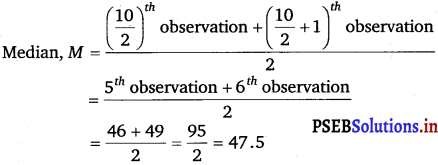
The deviations of the respective observations from the median i.e.,xi – M, are – 11.5, – 5.5, – 2.5, – 1.5, – 1.5, 1.5, 3.5, 5.5, 12.5, 24.5
The absolute values of the deviations, |xi – M|, are 11.5, 5.5, 2.5, 1.5, 1.5, 1.5, 3.5, 5.5, 12.5, 24.5.
Thus, the required mean deviation about the median is
M.D.(M) = \(\frac{\sum_{i=1}^{10}\left|x_{i}-M\right|}{10}\)
= \(\frac{11.5+5.5+2.5+1.5+1.5+1.5+3.5+5.5+12.5+24.5}{10}\)
= \(\frac{70}{10}\) = 7.
![]()
Question 5.
Find the mean deviation about the median for the data.

Answer.

Question 6.
Find the mena deviation about the mean for the data.

Answer.
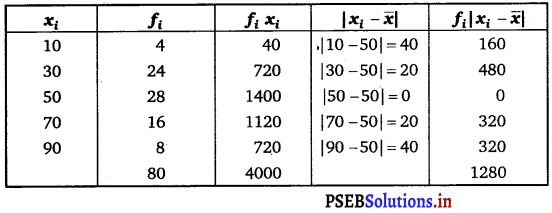
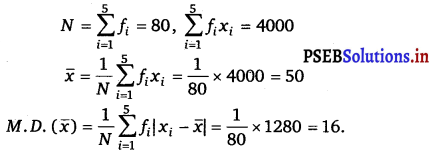
![]()
Question 7.
Find the men and deviation about the mean for the data.

Answer.
The given observations are already in ascending order. Adding a column corresponding to cumulative frequencies of the given data, we obtain the following table.

Here, N = 26, which is even.
Median is the mean of 13th and 14th observations. Both of these observations lie in the cumulative frequency 14, for which the corresponding observation is 7.
∴ Median, (M) = \(\frac{13^{\text {th }} \text { observation }+14^{\text {th }} \text { observation }}{2}=\frac{7+7}{2}\) = 7
The absolute values of the deviations, i.e., |xi – M|, are
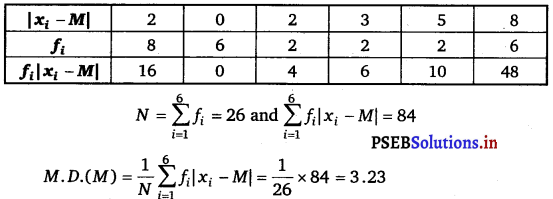
Question 8.
Find the mean deviation about the median for the data.

Answer.
Here, N = Σfi = 29, which is odd. So, the median is the \(\left(\frac{n+1}{2}\right)^{\text {th }}\) observation i.e., \(\frac{29+1}{2}\) = 15th observation, which is equal to 30. Thus, median is 30.

∴ Mean deviation from the median = \(\frac{\sum f_{i}\left|x_{i}-30\right|}{\sum f_{i}}\)
= \(\frac{148}{29}\) = 5.1.
![]()
Question 9.
Find the mean deviation about the mean for the data.
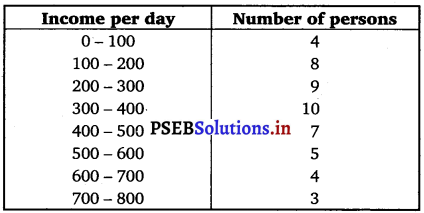
Answer.
The following table is formed.
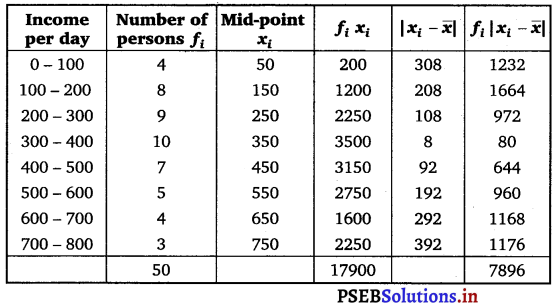

Question 10.
Find the mean deviation about the mean for the data.
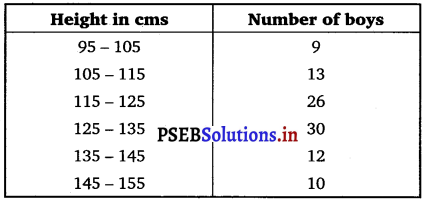
Answers.
The following table is formed.
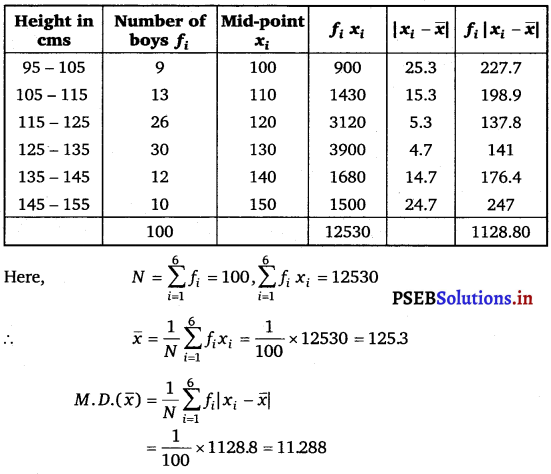
![]()
Question 11.
Find the mean deviation about median for the following data.

Answer.
Table to find cumulative frequencies and Σfi |xi – M| is given below :

Now C = 14, class corresponding to cumulative frequency 28 is 20 – 30.
∴ l = 20, f = 14, h = 10
Median = l + \(\frac{\frac{N}{2}-C}{f}\) × h
= 20 + \(\frac{25-14}{14}\) × 10
= 20 + \(\frac{11}{14}\) × 10
= 20 + 7.86 = 27.86 14
Σfi |xi – M| = 517.16
∴ Mean devintion about median = \(\frac{517.16}{50}\) = 10.34.
![]()
Question 12.
Calculate the mean deviation about median age for the age distribution of 100 persons given below:
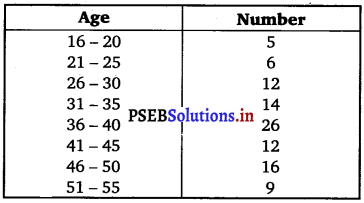
Answer.
We make the table from the given data.
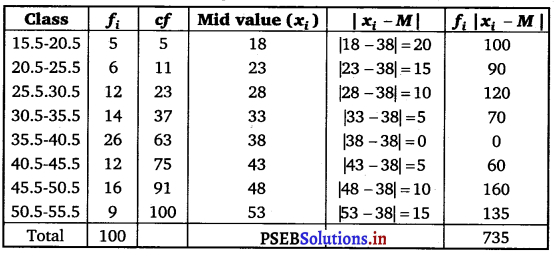
Here, N = 100
∴ \(\frac{N}{2}\) = 50
So, median class is 35.5 – 40.5
∴ l = 35.5, cf = 37, f = 26,h = 5
∵ M = l + \(\frac{\frac{N}{2}-c f}{f}\) × h
M = 35.5 + \(\frac{50-37}{26}\) × 5
= 35.5 + \(\frac{13}{26}\) × 5
= 35.5 + 2.5 = 38
∴ Mean deviation about median = \(\frac{\sum f_{i}\left|\boldsymbol{x}_{i}-M\right|}{\sum f_{i}}=\frac{735}{100}\) = 7.35
Hence, the mean deviation about median is 7.35.
